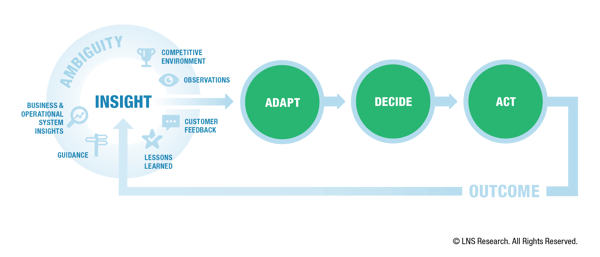Agility, adaptation, and innovation are prized commodities in today’s business climate. Disruption is top of mind because it is a genuine opportunity and risk. Today’s manufacturers are exposed to unprecedented external forces, but also have the potential to access unprecedented insights. These insights can lead to innovative products, achieve new levels of quality and productivity, and create innovative new customer experiences. The end effect is that highly agile, and digitalized startups have managed to topple established industries and manufacturers that have been slow to adapt.
How can firms innovate? Insights are essential in this new digitalized world, but are not the only consideration, because even with the best of insights, are the correct subject matter experts involved that can interpret the insights to lead adaptation? Will internal biases prevent teams from pivoting to the best competitive decision? Will internal friction slow decision-making?
LNS’s recent successful new product introduction (NPI) research identified that manufacturers must:
- establish strategic alignment between the many stakeholders in NPI,
- improve processes, data management, and metrics to increase collaboration, and
- build and execute a digitalization strategy.
The Digital Innovation Cycle marries these into a cycle that drives innovation and disruption and enables manufacturers to excel in today’s market trends. It provides a framework that considers how we capture insights, adapt perspectives on the market, decide to commit resources based on the new views, competently act, and drive outcomes, ideally towards the identified objectives.
It works with existing NPI processes such as Phase-Gate or Agile, and processes such as Plan-Do-Check-Act. The Digital Innovation Cycle provides a different perspective on decision-making,embeding innovation and digital insights into existing processes.
Insight, Adapt, Decide, Act: Four Stages of The Digital Innovation Cycle
- INSIGHT. Insights are the data and observation inputs, which can come from traditional sources as well as digitalized sources.
- ADAPT. Insights are analyzed and used to synthesize new concepts.
- DECIDE. Compare multiple concepts, decide and catch the competition off-beat.
- ACT. Disrupt by executing well, with the right competencies, technological support, collaboration, and feedback loop.
Some Considerations:
Data: Digitalized inputs include internally owned Industrial Internet of Things (IIoT) data from manufacturing, laboratory operations, and in-service operation. It also spans external information such as those from social media and online marketplaces, customer operation of equipment, the value chain, and regulators. Some data has joint ownership as well. Data ownership and control is an important consideration, because while data may exist, the manufacturer may not have access to it.
Insight ambiguity is a crucial consideration. Ambiguity always exists, but to what extent in your NPI cycle? How well do you truly know the customers’ use cases and expectations? How well do you capture lessons learned from prior products? LNS data indicates the leading source of lessons learned is quality management data, which for many is highly fragmented and therefore ambiguous. Conversely, connected operations and connected products provide the opportunity to add clarity and better inform the Digital Innovation Cycle, but these are presently lightly adopted.
Resource Scarcity: One of the underlying elements of the cycle is resource scarcity, which is indeed a limiting factor in NPI. Shortage of talent, time, and finances are all significant concerns. Although LNS Research has identified that companies invest a median of 25% of their personnel into NPI, all the teams have many responsibilities. NPI time to market is a top of mind concern from top management down, as are development costs.
Cooperation or Competition: Unfortunately, these scarce resources can compete, and often do – particularly in late cycle changes. Individuals and groups can cooperate to meet shared goals or compete when different goals collide. The decision to cooperate or compete is based on the ability to overcome obstacles in the way of achieving goals.
That should sound familiar to the many cross-functional teams that need to cooperate in the NPI process but are often engaged too late. LNS data indicates that this is a top challenge for many teams in NPI, including those managing requirements, risk, suppliers, production planning, and quality.
One takeaway to think about: there are multiple goals in NPI, many of which can conflict if the obstacles to cooperate are too high. Barriers are at the heart of the cooperation/competition dynamic. Where can obstacles be reduced to improve cooperation?
Importance of collective experience: Collective experience is critical to the Digital Innovation Cycle. When exposed to new data, we analyze the data to understand what the data is telling us, then use creative induction to identify new approaches based on insight patterns and grouping. Creative induction uses prior experiences to put the insights in context and form new hypotheses. By leveraging experiences across the organization, we synthesize the new information to arrive at a better picture of reality, which drives better decisions. Sharing observations quickly with the collective team, can help make better decisions more swiftly.
